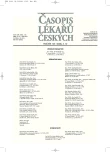Examination of the Vestibular System in Multiple Sclerosis
Vyšetření vestibulárního systému u roztroušené sklerózy
Cílem sdělení je stručně seznámit čtenáře s využitím neurootologických elektrofyziologických metod v diferenciální diagnostice roztroušené sklerózy. Jedná se o chronické invalidizující onemocnění charakterizované mnohočetnými ložisky demyelinizace v bílé hmotě centrálního nervového systému. Projevem postižení rovnovážného systému v rámci onemocnění je vertigo. Z uvedeného přehledu vyplývá, že nejužitečnější informace u pacientů s vertigem podávají dynamická posturografie a elektronystagmografie.
Klíčová slova:
roztroušená skleróza, vertigo, kmenové sluchové evokované potenciály, dynamická posturografie, elektronystagmografie.
Authors:
G. Achiemere
Authors‘ workplace:
Otorinolaryngologická klinika 3. LF UK a FNKV, Praha
Published in:
Čas. Lék. čes. 2006; 145: 905-906
Category:
Review Article
Overview
The aim of the review is to provide a comprehensive actual overview of the current approach to the use of neurootologic electrophysiological methods in diagnostic process of multiple sclerosis. Chronic and debilitating forms of the disease are characterized by multiple areas of focal demyelinization that develop throughout the white matter of the central nervous system. The manifestation of the affection of the balance system is dizziness. The data suggest that dynamic posturography and electronystagmography can provide useful diagnostic information in patients with balance disturbances.
Key words:
multiple sclerosis, dizziness, brainstem electric response audiometry, dynamic posturography, electronystagmography.
Labels
Addictology Allergology and clinical immunology Angiology Audiology Clinical biochemistry Dermatology & STDs Paediatric gastroenterology Paediatric surgery Paediatric cardiology Paediatric neurology Paediatric ENT Paediatric psychiatry Paediatric rheumatology Diabetology Pharmacy Vascular surgery Pain management Dental HygienistArticle was published in
Journal of Czech Physicians

- Metamizole vs. Tramadol in Postoperative Analgesia
- Advances in the Treatment of Myasthenia Gravis on the Horizon
- Obstacle Called Vasospasm: Which Solution Is Most Effective in Microsurgery and How to Pharmacologically Assist It?
- Current Insights into the Antispasmodic and Analgesic Effects of Metamizole on the Gastrointestinal Tract
- Spasmolytic Effect of Metamizole
Most read in this issue
- Hair Whorl-A Genetically Bound Phenomenon in Testing of Right-handedness and Hemispheric Dominance
- Dermatophytoses Transmitted from Animals
- Tako-tsubo Cardiomyopathy – Our Experience and Review of Current Knowledge
- Geriatric View on the Health and Disease in Old Age – Changes in the Paradigm?
